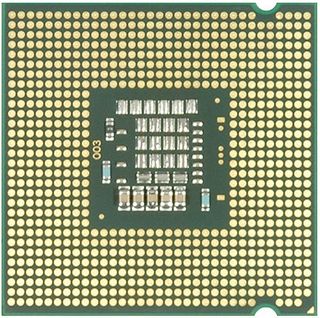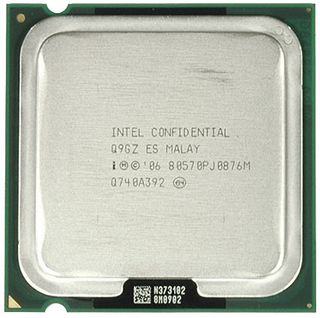Wolfdale Shrinks Transistors, Grows Core 2
Core 2 Duo E8000 Series

There are currently three versions available. Core 2 Duo E8200 runs at 2.66 GHz; E8400 has a 3.0 GHz clock speed and the top model, the E8500, runs at 3.16 GHz. If you paid close attention you will realize that Intel has re-introduced odd multipliers, because reaching 3.16 GHz on a 333 MHz base clock requires a multiplier of x9.5. And you might also have realized that there is no E8300 (yet). This model would close the existing gap and use the x8.5 multiplier to reach 2.83 GHz. We believe that Intel (and its partners) might want to sell all mainstream Core 2 Duo E6x50 processors first prior to releasing this sweet spot model.
All three models incorporate all of Intel's latest processor technologies including support for 64 bit operating systems (4 GB and more will require a 64 bit OS), the XD bit, Enhanced SpeedStep and Virtualization Technology. All of them are based on the Core 2 micro architecture and 6 MB L3 cache. Future versions with only 3 MB cache could very well be called Core 2 Duo E5000, which would fit in between the 2 MB E4000 and the 4 MB E6000 series.
Currently there is no dual core Extreme Edition processor available, but only the QX9650 Core 2 Extreme quad core Compare Prices on Core 2 Extreme QX9650. Intel has been offering Extreme Edition models to allow enthusiasts to overclock their processors at will. Therefore, Extreme Edition CPUs come with unlocked multipliers, which means that you could set a 3.16 GHz processor to run at 3.33, 3.5 or 3.66 GHz by only changing the multiplier from x9.5 to x10, x10.5, x11 - or even faster. Our overclocking attempts, which we will discuss in part 2 of this article, yielded well above 4 GHz clock speed and we aren't sure whether the processor's system bus or the core itself was the limit. Clearly, we would love to see a dual core Extreme Edition again - but at more acceptable prices than the usual $999 price points.
We found that the new E8000 series processors ran amazingly cool. While they provide some per cent better performance across the majority of our benchmark suite, the processor cooling systems for our test systems would even stop when our Wolfdale test systems were idle. This means that the idle power of a Core 2 Wolfdale at 2.0 GHz (and probably at a deep C state) is low enough to be dissipated by your heat sink without the fan. At maximum stock clock speed of 3.16 GHz, we still had exceptionally low temperature readings. When compared to the 65 nm Core 2 Conroe, the new 45 nm Core 2 Wolfdale runs at least 6-8 degrees Centigrade cooler. If the Deep Power Down state were available, the processor would clearly consume less energy than the chipset. While this type of progress will hardly be noticed by your average user, it actually gets me more excited than a few percent-point performance gains. Indeed, Wolfdale-based PCs will be better adapted to deliver high-performance levels when required, while they will run cool enough so that PCs will also run quieter.


Stay on the Cutting Edge
Join the experts who read Tom's Hardware for the inside track on enthusiast PC tech news — and have for over 25 years. We'll send breaking news and in-depth reviews of CPUs, GPUs, AI, maker hardware and more straight to your inbox.
Most Popular


